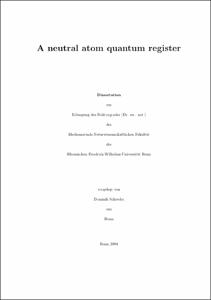Schrader, Dominik: A neutral atom quantum register. - Bonn, 2005. - Dissertation, Rheinische Friedrich-Wilhelms-Universität Bonn.
Online-Ausgabe in bonndoc: https://nbn-resolving.org/urn:nbn:de:hbz:5N-04870
Online-Ausgabe in bonndoc: https://nbn-resolving.org/urn:nbn:de:hbz:5N-04870
@phdthesis{handle:20.500.11811/2129,
urn: https://nbn-resolving.org/urn:nbn:de:hbz:5N-04870,
author = {{Dominik Schrader}},
title = {A neutral atom quantum register},
school = {Rheinische Friedrich-Wilhelms-Universität Bonn},
year = 2005,
note = {In this thesis I present the realization of a quantum register of single neutral atoms, which is a building block of a quantum computer. It consists of a well known number of "qubits" - the quantum analogs of classical bits - that can be individually addressed and coherently manipulated. Here, a string of single cesium atoms trapped in the potential wells of a standing wave optical dipole trap serves as quantum register. The quantum information is encoded into the hyperfine states of the atoms which are coherently manipulated using microwave radiation.
Chapter 1 is devoted to the presentation of a number of tools to control all degrees of freedom of single neutral atoms. A magneto-optical trap provides an exactly known number of cold atoms which are transferred into an optical dipole trap. A photon-counting CCD camera along with molasses cooling allow us to continuously observe the trapped atoms including their controlled transport along the trap axis using our optical "conveyor belt". Finally, I present techniques to initialize, coherently manipulate and measure the hyperfine states of individual atoms with high efficiency.
The experimental realization of the quantum register is the focus of Chapter 2, where I describe its working principle and fully characterize its properties. Write and read operations on the quantum register are performed by position-selective coherent manipulation of atom qubits and state-selective measurements. For this purpose, an image is acquired to determine the positions of all trapped atoms. A magnetic field gradient is applied along the trap axis so that individual atom qubits are addressed by tuning the frequency of the microwave radiation to the respective Zeeman-shifted atomic resonance frequency. This addressing scheme operates with a spatial resolution of 2.5µm and qubit rotations on individual atoms are performed with 99% contrast including all experimental imperfections. In a final read-out operation each individual atomic state is analyzed. I finally investigate the coherence properties of the quantum register in detail and identify the mechanisms that lead to decoherence.},
url = {https://hdl.handle.net/20.500.11811/2129}
}
urn: https://nbn-resolving.org/urn:nbn:de:hbz:5N-04870,
author = {{Dominik Schrader}},
title = {A neutral atom quantum register},
school = {Rheinische Friedrich-Wilhelms-Universität Bonn},
year = 2005,
note = {In this thesis I present the realization of a quantum register of single neutral atoms, which is a building block of a quantum computer. It consists of a well known number of "qubits" - the quantum analogs of classical bits - that can be individually addressed and coherently manipulated. Here, a string of single cesium atoms trapped in the potential wells of a standing wave optical dipole trap serves as quantum register. The quantum information is encoded into the hyperfine states of the atoms which are coherently manipulated using microwave radiation.
Chapter 1 is devoted to the presentation of a number of tools to control all degrees of freedom of single neutral atoms. A magneto-optical trap provides an exactly known number of cold atoms which are transferred into an optical dipole trap. A photon-counting CCD camera along with molasses cooling allow us to continuously observe the trapped atoms including their controlled transport along the trap axis using our optical "conveyor belt". Finally, I present techniques to initialize, coherently manipulate and measure the hyperfine states of individual atoms with high efficiency.
The experimental realization of the quantum register is the focus of Chapter 2, where I describe its working principle and fully characterize its properties. Write and read operations on the quantum register are performed by position-selective coherent manipulation of atom qubits and state-selective measurements. For this purpose, an image is acquired to determine the positions of all trapped atoms. A magnetic field gradient is applied along the trap axis so that individual atom qubits are addressed by tuning the frequency of the microwave radiation to the respective Zeeman-shifted atomic resonance frequency. This addressing scheme operates with a spatial resolution of 2.5µm and qubit rotations on individual atoms are performed with 99% contrast including all experimental imperfections. In a final read-out operation each individual atomic state is analyzed. I finally investigate the coherence properties of the quantum register in detail and identify the mechanisms that lead to decoherence.},
url = {https://hdl.handle.net/20.500.11811/2129}
}






